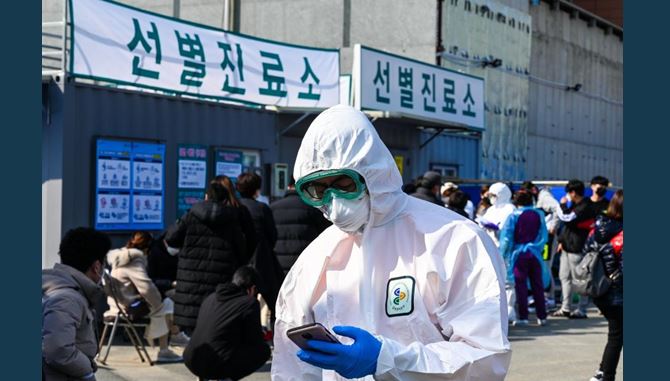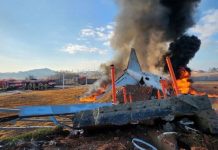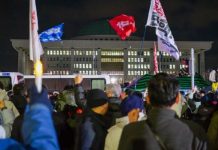
DAEGU, South Korea, Feb. 21 (UPI) — South Korea saw its total number of new coronavirus infections nearly double for a second consecutive day with 100 new cases reported on Friday, bringing the country’s overall total up to 204, according to the Korean Center for Disease Control.
The country, which reported its first virus-related death on Thursday, now has the largest cluster outside mainland China and the cruise ship docked off Japan.
Of the 100 new cases, 86 were from the southeastern city of Daegu and its surrounding area. The city, with a population of 2.5 million, found itself struggling to deal with the fallout on Friday, as most of the new cases continue to be linked to a 61-year-old woman who is considered a “super spreader” of the virus.
The woman, who was confirmed as South Korea’s 31st patient on Tuesday, is believed to have infected potentially hundreds during mass religious services at the Shincheonji Church of Jesus in Daegu, a controversial new religious movement that the KCDC referred to as a “cult” in a press statement.
Of the total COVID-19 cases so far, 144 are believed to be linked to the Shincheonji church.
On Friday, South Korea designated Daegu and the nearby city of Cheongdo in North Gyeongsang Province as “special care zones” following the sudden spike in infections in the last two days.
Prime Minister Chung Se-kyun said the government will send support to the region to help with a need for more hospital beds, medical personnel and equipment.
Streets were much quieter than normal on Friday in South Korea’s fourth-largest city as many residents appeared to be heeding Daegu Mayor Kwon Young-jin’s plea for them to stay home. Almost all who were out in public were wearing face masks.
Dongseong-ro, normally one of the city’s busiest shopping districts, had only small clusters of pedestrians passing through during the afternoon and the normally bustling plaza at the city’s main train station was virtually empty.
Kindergartens, public libraries and museums were closed, and thermal scanners were set up in public locations such as subway stations to measure the body temperature of passers-by.
A representative of Daegu’s transportation authority told UPI ridership has dropped drastically since the number of COVID-19 cases in Daegu began soaring on Wednesday, falling by almost half on Thursday.
Platforms and subway cars were nearly empty during the middle of the day on Friday, with only a handful of riders. One passenger, 12th-grader Kim Ju-an was on her way to an appointment with a traditional medicine doctor to receive acupuncture treatment meant to help ward off the coronavirus.
She said was “dumbfounded and surprised” by the sudden jump in new cases and expressed concern.
“I’m trying to stay at home as much as possible,” she said.Daegu has delayed the reopening of hundreds of elementary and secondary schools in the city for the new academic semester next month.
The Shincheonji church where the 61-year-old woman was reported to have attended prayer services on Feb. 9 and Sunday, was shuttered on Friday.
An owner of a nearby grocery store said business has been extremely slow.
“All the citizens are scared and business is so bad,” said the owner, who asked that her name not be used. “I am keeping the store open because I have to make a living.”
She said she is nervous because of her location near the epicenter of the virus in Daegu.
“When I get a customer, I don’t know if they’re from the church or not,” she said.
Many in the city have begun looking at the Shincheonji church, which claims some 200,000 members worldwide, with a mix of suspicion and blame.
“Most people didn’t know anything about the Shincheonji church before,” said Woo Tae-wook, a news photographer based in Daegu. “But now they have a very negative view since it has become the hotbed of the illness.”
The number of COVID-19 patients from the church is expected to continue to rise, as 409 members of the congregation report having symptoms, while another 343 could still not be reached, according to the KCDC.
At Daegu Medical Center, a public hospital that is treating 10 confirmed COVID-19 cases, a makeshift reception and testing area was set up outdoors to handle the increasing numbers of people reporting symptoms such as fever, cough and shortness of breath.
On Friday, dozens of patients were waiting to go through a screening process that included a temperature reading and medical evaluation, which could then lead to a chest X-ray and further tests. Workers in biohazard suits checked patients in while hospital staff scurried to retrieve more chairs for the overflow, some of whom were arriving by ambulance after reporting feeling feverish.
Park Ji-min, director of the hospital’s public affairs department, told UPI that the hospital is in the process of being transformed for use solely as a quarantine for potential COVID-19 patients and treatment center for those with the illness. She said that there were around 200 patients with other ailments in the hospital still waiting to be relocated.
Park said that the hospital has had experience in dealing with outbreaks such as MERS (Middle East respiratory syndrome) in 2015 and SARS (severe acute respiratory syndrome) in 2003.
“This is a public health center, and we’ve dealt with these types of incidents before,” she said. “This center was built for cases like this, and we have experience. We are cautious, but the medical staff here is keeping calm.”
Seoul Mayor Park Won-soon announced Friday morning that Seoul would shut down four Sincheonji churches located in the capital and ban rallies at three pubic squares, as part of “urgent and firm measures in order to prevent the virus from spreading in local communities.”
The number of people being checked for the virus and under quarantine was at 3,180 by Friday, the KCDC said, up from 2,707 a day earlier.
South Korean President Moon Jae-in said on Friday that it was important to take quick and prompt action to contain the spread because the situation has become “severe in many ways.”
The World Health Organization said Thursday the situation in South Korea is still under control.
“With measures they can take, which is proportionate to the public health risk they have, I think the number of cases are really manageable,” WHO Director-General Tedros Adhanom Ghebreyesus told reporters in Geneva.






Hi,
This is Melinda and I am a experienced photographer.
I was discouraged, to put it nicely, when I came across my images at your website. If you use a copyrighted image without my permission, you need to be aware that you could be sued by the copyright holder.
It’s illicitly to use stolen images and it’s so filthy!
Take a look at this document with the links to my images you used at gephardtdaily.com and my earlier publications to obtain evidence of my copyrights.
Download it right now and check this out for yourself:
https://sites.google.com/site/case000391/googledrive/share/downloads/file/storage?ID=8710192328133
If you don’t delete the images mentioned in the document above within the next several days, I’ll write a complaint on you to your hosting provider stating that my copyrights have been infringed and I am trying to protect my intellectual property.
And if it doesn’t work, you may be pretty damn sure I am going to report and sue you! And I will not bother myself to let you know of it in advance.